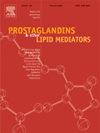Aspirin-triggered RvD1 (AT-RvD1) modulates epithelial-mesenchymal transition on bronchial epithelial cells stimulated with cigarette smoke extract
IF 2.5
3区 生物学
Q3 BIOCHEMISTRY & MOLECULAR BIOLOGY
Prostaglandins & other lipid mediators
Pub Date : 2025-02-19
DOI:10.1016/j.prostaglandins.2025.106968
引用次数: 0
Abstract
The epithelial-mesenchymal transition (EMT) plays significant role in airway remodeling during chronic obstructive pulmonary disease (COPD) and lung cancer. Aspirin-triggered resolvin D1 (AT-RvD1) presents anti-inflammatory and pro-resolution effects, via lipoxin A4 receptor/formyl peptide receptor 2 (ALX/FPR2). In addition, AT-RvD1 prevented TGF-β1-induced EMT in lung cancer cells (A549 cells). Here, we extend these results and evaluated the role of AT-RvD1 in cigarette smoke extract (CSE)-induced EMT on bronchial epithelial cells (BEAS-2B). CSE decreased E-cadherin expression, an epithelial marker, and increased ROS and TGF-β1 productions, and expressions of mesenchymal markers (N-cadherin, vimentin, smad2/3 and slug). Furthermore, CSE induced an increase in the ALX/FPR2 receptor expression. AT-RvD1 restored the expression of E-cadherin and reduced the N-cadherin, Vimentin, smad2/3 and ALX/FPR2 expressions as well as ROS and TGF-β1 productions on CSE-stimulated cells. In conclusion, AT-RvD1 has the potential to control epithelial-mesenchymal transition induced by smoking in the normal lung epithelial cells.
阿司匹林触发的RvD1 (AT-RvD1)调节香烟烟雾提取物刺激支气管上皮细胞的上皮-间质转化
上皮-间质转化(EMT)在慢性阻塞性肺疾病(COPD)和肺癌患者气道重塑中起重要作用。阿司匹林触发的溶解蛋白D1 (AT-RvD1)通过脂素A4受体/甲酰基肽受体2 (ALX/FPR2)具有抗炎和促溶解作用。此外,AT-RvD1可阻止TGF-β1诱导的肺癌细胞(A549细胞)EMT。在这里,我们扩展了这些结果,并评估了AT-RvD1在香烟烟雾提取物(CSE)诱导的支气管上皮细胞(BEAS-2B)的EMT中的作用。CSE降低了上皮标志物E-cadherin的表达,增加了ROS和TGF-β1的产生以及间质标志物(N-cadherin、vimentin、smad2/3和slug)的表达。此外,CSE诱导ALX/FPR2受体表达增加。AT-RvD1恢复了cse刺激细胞E-cadherin的表达,降低了N-cadherin、Vimentin、smad2/3和ALX/FPR2的表达以及ROS和TGF-β1的产生。综上所述,AT-RvD1具有控制吸烟诱导的正常肺上皮细胞上皮-间质转化的潜力。
本文章由计算机程序翻译,如有差异,请以英文原文为准。
求助全文
约1分钟内获得全文
求助全文
来源期刊

Prostaglandins & other lipid mediators
生物-生化与分子生物学
CiteScore
5.80
自引率
3.40%
发文量
49
审稿时长
2 months
期刊介绍:
Prostaglandins & Other Lipid Mediators is the original and foremost journal dealing with prostaglandins and related lipid mediator substances. It includes basic and clinical studies related to the pharmacology, physiology, pathology and biochemistry of lipid mediators.
Prostaglandins & Other Lipid Mediators invites reports of original research, mini-reviews, reviews, and methods articles in the basic and clinical aspects of all areas of lipid mediator research: cell biology, developmental biology, genetics, molecular biology, chemistry, biochemistry, physiology, pharmacology, endocrinology, biology, the medical sciences, and epidemiology.
Prostaglandins & Other Lipid Mediators also accepts proposals for special issue topics. The Editors will make every effort to advise authors of the decision on the submitted manuscript within 3-4 weeks of receipt.
 求助内容:
求助内容: 应助结果提醒方式:
应助结果提醒方式:


